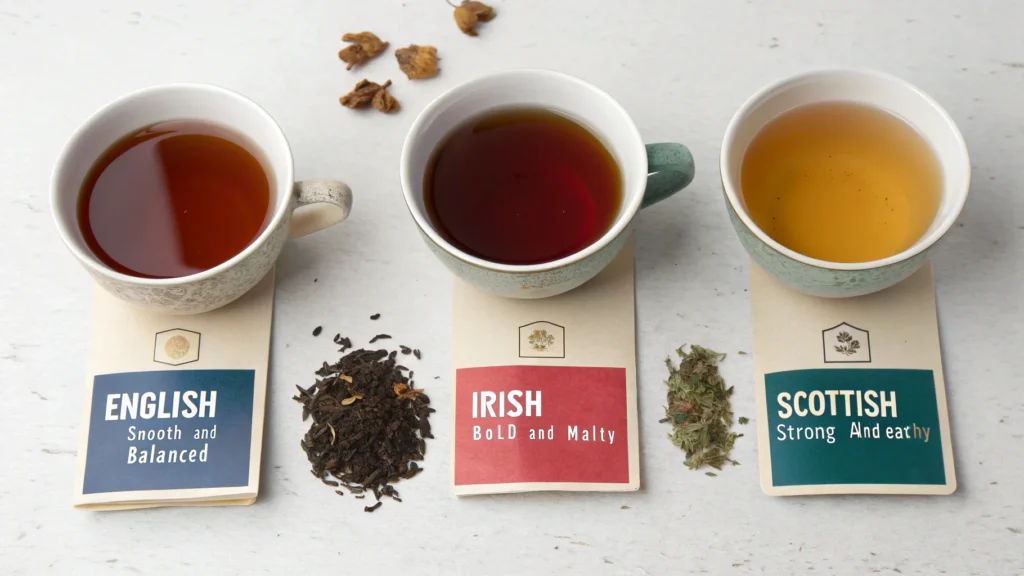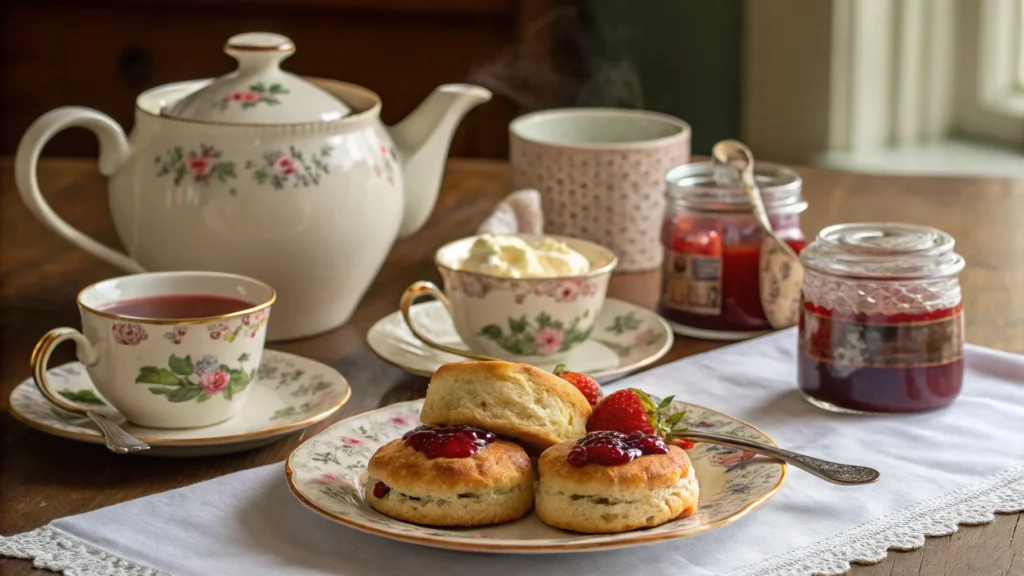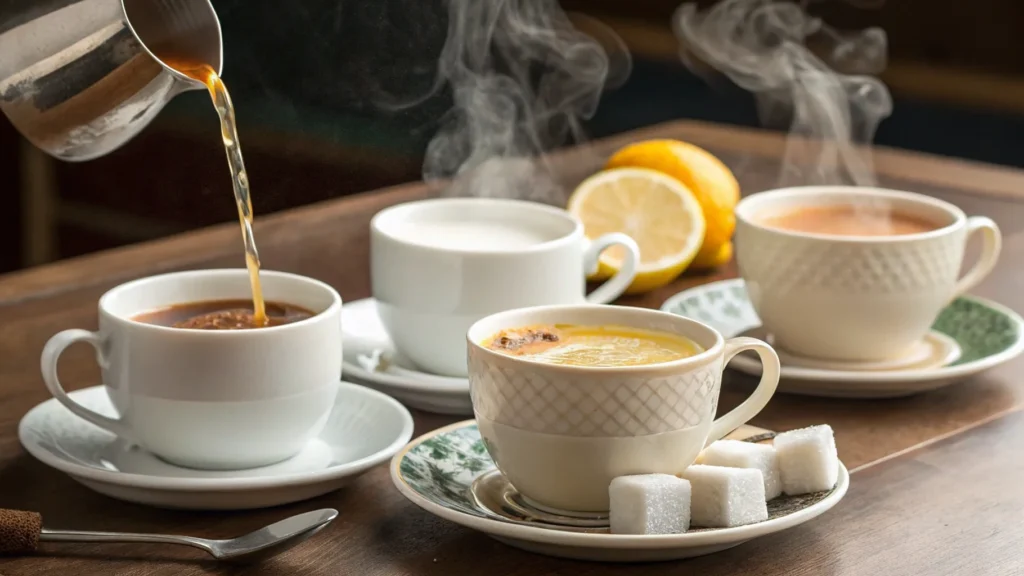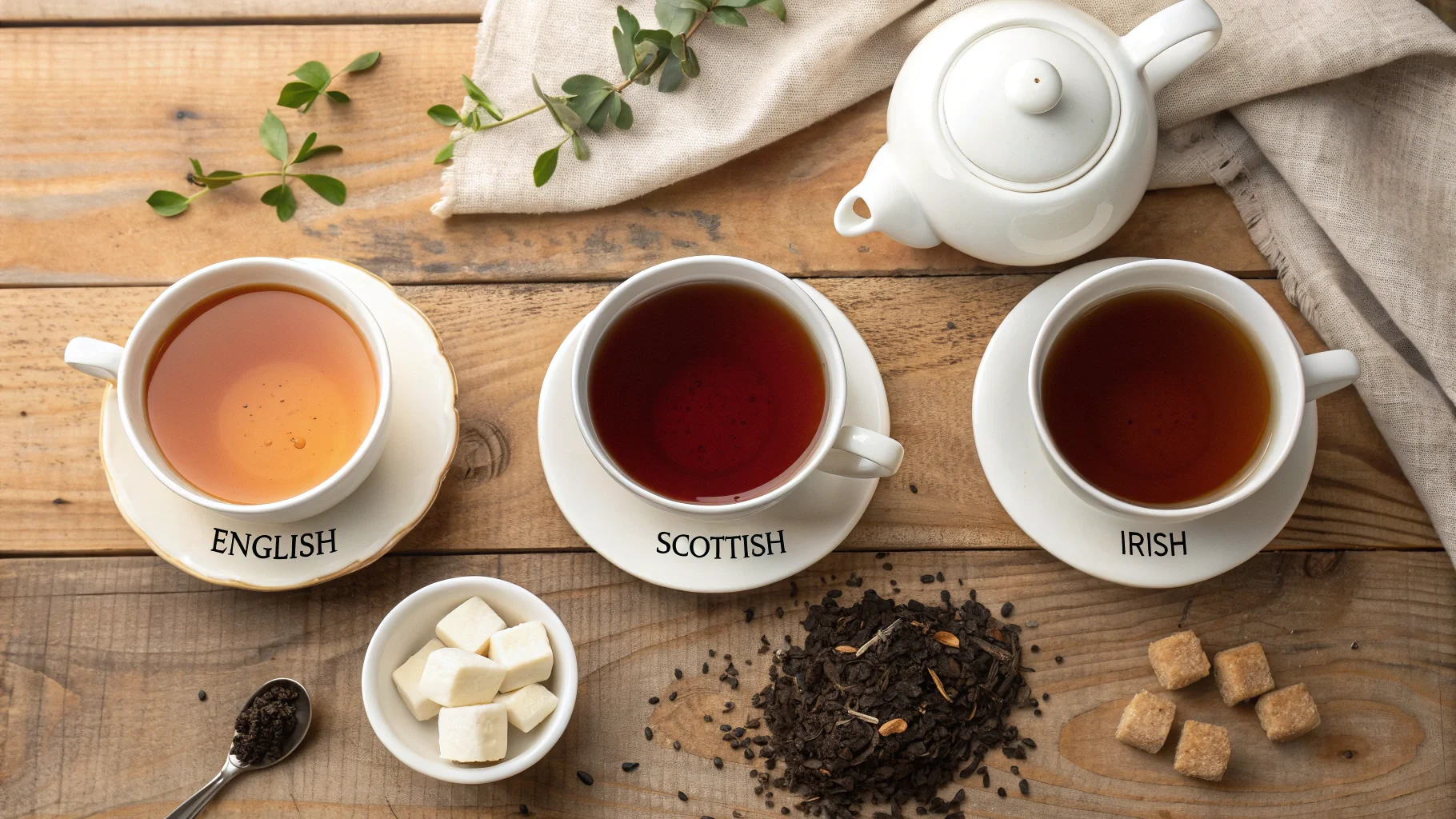Breakfast teas are a cherished tradition, with distinct blends capturing the heart of English, Irish, and Scottish cultures. These teas, though grouped under the umbrella of “breakfast tea,” have unique characteristics that set them apart. From the bold malty flavors of Irish breakfast tea to the refined smoothness of English blends, and the adaptability of Scottish tea to its soft water, each offers a fascinating glimpse into its regional roots.
This article dives deep into the differences between these iconic teas, exploring their histories, flavor profiles, and cultural significance. Whether you’re a seasoned tea drinker or new to the world of breakfast teas, this guide will help you discover the nuances of these beloved brews.
Table of contents
Introduction to Breakfast Teas
Overview of Breakfast Teas
Breakfast teas are robust black tea blends crafted to pair perfectly with hearty morning meals. They’re designed to wake you up, offering a caffeine boost and a rich, satisfying flavor. While the term “breakfast tea” might sound generic, it represents a long-standing tradition that varies greatly by region.
In England, Ireland, and Scotland, tea drinking is deeply ingrained in daily life. These countries have perfected their own versions of breakfast teas, each reflecting their unique culture, taste preferences, and even local water characteristics. Whether it’s the earthy maltiness of Irish blends, the refined richness of English tea, or the full-bodied strength of Scottish varieties, there’s a story behind every cup.
Historical Roots of Breakfast Teas
Breakfast teas date back to the 19th century, with origins often attributed to England. They were initially inspired by the need for a strong beverage that complemented traditional breakfasts. Over time, the concept spread to Ireland and Scotland, where local tastes shaped distinctive blends.
Interestingly, the composition of breakfast teas evolved alongside trade routes and the introduction of teas from regions like Assam, Ceylon, and China. The inclusion of Assam tea brought a malty depth, while Ceylon tea added brightness, creating versatile blends suited to different palates.
Importance of Regional Blends
What makes breakfast teas so fascinating is how they’ve adapted to regional preferences. English breakfast teas are typically balanced and smooth, perfect for sipping throughout the day. Irish breakfast teas, on the other hand, lean towards boldness, often enjoyed with milk and sugar to balance their strength. Scottish breakfast teas, crafted to complement soft water, are uniquely robust and sometimes include China tea for a smoky undertone.
Together, these blends showcase the versatility of tea and its ability to reflect cultural identity. From their histories to their flavors, breakfast teas are much more than just a morning pick-me-up—they’re a celebration of regional tradition.

What is English Breakfast Tea?
Origins and History of English Breakfast Tea
English breakfast tea is a classic blend that has become a staple in tea culture around the world. Originating in England during the 19th century, it gained popularity as a strong yet smooth tea that paired perfectly with the hearty English breakfast. Some credit Queen Victoria for popularizing the blend, while others suggest it was first crafted by a Scottish tea master in the Highlands.
Over time, the blend evolved to include black teas from regions like Assam, Ceylon, and Kenya. This combination created a balanced flavor profile that made it a favorite not only in England but across the globe.
Flavor Profile and Key Ingredients
The hallmark of English tea is its smooth and well-rounded taste. Typically, it includes a mix of Assam tea for malty depth and Ceylon tea for a bright, citrusy note. This balance creates a medium-bodied tea that is neither overly strong nor too mild, making it versatile and approachable.
When brewed, the tea has a dark amber hue and a robust flavor that’s slightly sweet, with a touch of bitterness to enhance complexity. English tea is often enjoyed with milk and sugar, but it’s equally satisfying on its own.
Cultural Significance in England
In England, tea isn’t just a beverage—it’s an institution. English tea, in particular, is deeply rooted in the tradition of tea time, symbolizing comfort and routine. Whether served during a formal afternoon tea or as a simple morning ritual, it’s cherished for its ability to bring people together.
Popular Brands of English Tea
Several brands have mastered the art of crafting English breakfast blends. Names like Twinings, Yorkshire Tea, and PG Tips are household staples, each offering slight variations to suit different palates. These brands ensure that whether you’re brewing a cup in London or abroad, you’re getting an authentic taste of this beloved tea.
What is Irish Breakfast Tea?
Origins and Evolution of Irish Tea
Irish breakfast tea emerged as a bold alternative to English blends, catering to Ireland’s preference for stronger flavors. It became particularly popular in the 19th century, when tea drinking spread widely across the country. The blend’s development was influenced by the Irish love for hearty flavors and the availability of Assam tea, which gave the blend its signature robustness.
While it shares some similarities with English breakfast tea, Irish breakfast tea is distinguished by its intensity and malty richness, making it a favorite among those who enjoy a stronger cup.
Flavor Characteristics and Assam Influence
The defining characteristic of Irish breakfast tea is its bold, malty flavor, a direct result of its high Assam content. This makes it darker, richer, and more robust than its English counterpart. When brewed, the tea has a reddish-brown color and a full-bodied taste that can stand up to milk and sugar, which are commonly added in Ireland.
Interestingly, the strong flavor of Irish breakfast tea complements Ireland’s traditional dishes, such as soda bread and hearty breakfasts, further embedding it into the country’s culinary heritage.
How Irish Water Affects the Tea’s Taste
Ireland’s naturally hard water plays a significant role in shaping the taste of Irish tea. The minerals in hard water enhance the malty notes of the tea, creating a brew that’s perfectly suited to the local water profile. This is why many Irish tea brands specifically design their blends to pair well with hard water.
Commonly Recommended Irish Tea Blends
Irish breakfast tea is widely available, with brands like Barry’s Tea and Bewley’s offering iconic blends. These brands have perfected the art of crafting teas that reflect Ireland’s love for bold flavors. For tea enthusiasts wondering, “What is the difference between English, Scottish, and Irish tea?”, trying Irish blends offers a clear example of how regional preferences influence tea crafting.
By combining strong Assam flavors with local brewing traditions, Irish breakfast tea stands out as a rich, robust beverage that perfectly captures Ireland’s vibrant tea culture.
What is Scottish Breakfast Tea?
The History and Heritage of Scottish Breakfast Tea
Scottish breakfast tea has a unique story, deeply tied to Scotland’s rugged landscape and cultural identity. While not as widely recognized as English or Irish blends, it has long been favored for its adaptability to Scotland’s soft water. Historically, tea drinking in Scotland gained momentum in the 19th century, as trade routes brought diverse tea varieties to the region.
Over time, Scottish tea makers created blends that stood out for their strength and complexity, ensuring they complemented both the local water profile and the hearty meals typical of Scottish cuisine.
Flavor Profile and Variations
Scottish breakfast tea is celebrated for its bold and robust flavor, which often surpasses the strength of its English and Irish counterparts. This tea blend typically includes a mix of Assam and other black teas, such as China teas, which add a smoky or earthy undertone. These elements create a brew that’s full-bodied and slightly stronger than other breakfast teas, making it perfect for those who prefer a hearty cup.
The color of Scottish breakfast tea is rich and dark, and its taste has a depth that holds up well to milk and sugar, common additions among tea drinkers in Scotland.
Unique Features Like Adaptation to Soft Water
One of the defining features of Scottish breakfast tea is its formulation for soft water. Scotland’s natural water profile enhances the tea’s flavor, allowing its maltiness and smokiness to shine through. This unique adaptability makes it a favorite in regions with similar water characteristics.
Scottish Tea Brands to Explore
For those curious about “What is the difference between English, Scottish, and Irish breakfast tea?”, trying authentic Scottish blends is a great way to discover their unique qualities. Popular brands like Brodies and Edinburgh Tea & Coffee Company offer blends crafted specifically for Scottish preferences.

Comparing English, Scottish, and Irish Breakfast Teas
Key Differences in Flavor Profiles
The question “What is the difference between English, Scottish, and Irish breakfast tea?” comes down to flavor and strength. English breakfast tea is smooth and balanced, offering a lighter cup that’s perfect for any time of day. Irish breakfast tea is bolder, with a malty and robust flavor thanks to its high Assam content. Meanwhile, Scottish breakfast tea is the strongest of the three, often including smoky or earthy undertones to enhance its full-bodied character.
Caffeine Content and Strength
When it comes to caffeine, Irish and Scottish blends typically have more punch than English breakfast tea, making them ideal for a morning boost. English breakfast tea, while less intense, still delivers enough caffeine to start the day, offering a gentler option for those who prefer a smoother brew.
Cultural Preferences and Drinking Habits
Cultural traditions also play a role in how these teas are enjoyed. English breakfast tea is often served during afternoon tea ceremonies, while Irish tea is a breakfast staple, frequently paired with hearty meals. Scottish tea, with its strong profile, is often reserved for those who prefer a bold start to their day.
Which Tea Suits You Best?
Choosing the right tea depends on your taste and preferences. If you enjoy a smooth, versatile tea, English breakfast is your go-to. For those who love a malty, bold cup, Irish breakfast tea is ideal. And if you prefer an intensely robust tea with earthy undertones, Scottish breakfast tea is your perfect match.
For readers interested in exploring more about Irish breakfast tea, check out this article on Recipesolly: The Unique Charm of Irish Breakfast Tea. It dives deeper into what makes Irish tea so special!
Brewing Tips and Pairings for Breakfast Teas
Optimal Brewing Techniques for Each Tea
Brewing breakfast teas might seem simple, but small tweaks can make a big difference in flavor. Whether you’re preparing English, Scottish, or Irish tea, start with fresh, filtered water for the best taste. Heat the water to a rolling boil, as black teas require high temperatures to release their full flavor.
For English tea, aim for a steeping time of 3-4 minutes to achieve its signature balance of smoothness and richness. Irish tea, being bolder, can handle a slightly longer steep time, around 4-5 minutes. Scottish tea, with its robust profile, is best brewed for 4-6 minutes to extract its full-bodied character.
Remember, over-steeping can lead to bitterness, so keep an eye on the clock. Pairing the tea with milk and sugar can also mellow stronger flavors, especially in Irish and Scottish blends.
Traditional Accompaniments
Breakfast teas are often paired with hearty foods, enhancing the experience. English tea goes wonderfully with buttered toast, scones, or jam. Irish tea pairs well with a full Irish breakfast or soda bread, complementing its malty depth. Scottish tea, with its boldness, matches perfectly with oatcakes, smoked salmon, or even a rich, meaty breakfast.
FAQs on Breakfast Teas
What Makes Breakfast Teas Different from Regular Black Teas?
Breakfast teas are blends crafted specifically for robust flavor and a caffeine boost, making them stronger and more versatile than single-origin black teas.
Can You Drink Tea All Day?
Absolutely! While they’re called “breakfast teas,” their balanced flavors make them suitable for any time of day. Add milk or sugar to adjust the strength for your preference.
Which Tea Has the Most Caffeine?
Irish and Scottish breakfast teas often contain more caffeine due to their high Assam content, while English breakfast tea has a slightly milder kick.
What’s the Healthiest Breakfast Tea Option?
All breakfast teas are rich in antioxidants. Choose a blend without added sugar or flavors for maximum health benefits. If caffeine is a concern, opt for decaffeinated versions.
These FAQs help clarify “What is the difference between English, Scottish, and Irish breakfast tea?”, offering insights into their unique characteristics and uses.

Conclusion
Personalizing Your Tea Experience
Choosing between English, Scottish, and Irish breakfast teas depends on your taste and preferences. If you love a smooth, versatile tea that works all day, English breakfast tea is a reliable choice. For a malty, bold flavor that pairs wonderfully with milk, Irish tea is the perfect option. Meanwhile, Scottish tea caters to those who prefer a robust, full-bodied brew with earthy undertones.
Knowing the difference between English, Scottish, and Irish breakfast tea is helpful. It allows you to choose the right tea for your taste and brewing style. Whether you enjoy your tea plain or with milk and sugar, these regional blends offer a rich variety to explore.
Final Thoughts on Regional Preferences
Each breakfast tea reflects the heritage and tastes of its region. Exploring these blends is like taking a flavorful journey through England, Ireland, and Scotland, one cup at a time.

